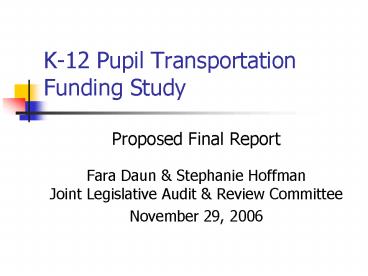K12 Pupil Transportation Funding Study - PowerPoint PPT Presentation
1 / 15
Title:
K12 Pupil Transportation Funding Study
Description:
K-12 Pupil Transportation Funding Study. Proposed Final Report. Fara Daun & Stephanie Hoffman ... Only 'To/From' Transportation is Eligible for State Funding ... – PowerPoint PPT presentation
Number of Views:63
Avg rating:3.0/5.0
Title: K12 Pupil Transportation Funding Study
1
K-12 Pupil Transportation Funding Study
- Proposed Final Report
- Fara Daun Stephanie HoffmanJoint Legislative
Audit Review Committee - November 29, 2006
2
Only To/From Transportation is Eligible for
State Funding
- Statute defines to/from transportation as
transportation between - Route stops and schools
- Schools, under an inter-district agreement
- Schools and learning centers for required
education (shuttles) - Schools and agencies for special education
- Other transportation refers to
- Field trips, athletic events, ASB Clubs, etc.
- Not eligible for State funding
2
Report pp. 1-2
3
Study Mandated in 2005-07 Operating Budget
- To what extent do school districts track or
report to/from pupil transportation costs? - To what extent does the current funding method
reflect the actual costs of providing to/from
pupil transportation? - Are there alternative funding methods that would
more accurately reflect the costs of providing
to/from pupil transportation? - Are there nationally recognized best practices
for funding pupil transportation? If so, does WA
follow them? Can any existing best practices be
applied in WA?
3
Report p. 1
4
Accounting Reporting IssuesFindings
- On a statewide basis, there is no systematic
method to account separately for to/from
transportation, and the tools that do exist are
incomplete and not audited. - Accounting and reporting of certain
transportation costs are not consistent across
districts. - E.g., Bus aides, utilities, insurance
4
Report pp 16-19
5
Accounting Reporting Issues Recommendation 1
- The Legislature should require districts to
separate to/from transportation costs from other
transportation costs when reporting expenditures,
so that the State can determine the extent to
which funding reflects eligible transportation
costs. - OSPI and OFM concur
5
Report p. 19
6
Accounting Reporting Issues Recommendation 2
- The Superintendent of Public Instruction, in
consultation with the State Auditor, should adopt
rules and clarify instructions for tracking and
reporting transportation costs. - OSPI and OFM concur
6
Report pp. 19-20
7
Current Funding MethodFinding
- On a statewide basis, JLARC estimates that there
is a 95 probability that to/from pupil
transportation expenditures exceeded state
funding by 93 ? 114 million in the 2004-05
school year.
- JLARC cautions the State to consider how it will
allocate funding to individual districts before
appropriating any additional funding.
7
Report pp. 25-31
8
Structure Implementation Findings
- The current funding method cannot generate
funding that reflects each districts actual
costs due to significant structural and
implementation problems. - Some districts receive more funding than expected
costs, most receive less. - The current funding method fails to drive
operational efficiencies.
8
Report pp. 33-42
9
Statutory WAC IssuesFinding
- Definitional issues in statute and WAC currently
prevent the funding method from reflecting actual
costs. - WAC definitions around eligible shuttles are
narrower than the statute. - Definitions in statute are unclear, missing, or
may be out of date.
9
Report pp. 38-39, 42
10
Statutory WAC Issues Recommendation 3
- The Legislature should review statutory language
to ensure that there is clarity around what
transportation costs the State intends to fund. - OSPI and OFM concur
10
Report p. 42
11
Statutory WAC Issues Recommendation 4
- OSPI should change its WACs to conform to statute
to ensure that all qualifying trips can generate
funding by the State. - OSPI and OFM concur
- OSPI adopted emergency WACs related to this
recommendation in August 2006
11
Report p. 42
12
Four Funding Methods Used Nationally
- Block Grant (13 states)
- Transportation funding is assumed to be part of
general K-12 grant - Approved Cost (7 states)
- Reimbursement for a percentage of eligible costs
- Per Unit Allocation (WA 11 other states)
- Fixed allocation per unit of service (miles,
students) - Predictive or Efficiency-Driven Formulas (13
states) - Designed to promote efficient behaviors
12
Report pp. 43-46, Appendix 5
13
Best Practices in Pupil Transportation
- No one funding method is considered a best
practice, but funding should recognize
differences in geography, topography, pupil
density. - Best operating practices include eligibility
requirements capacity utilization standards. - WAs funding method does not promote best
practices, but some districts appear to have
implemented best operating practices.
13
Report pp. 51-53
14
Current Funding Method Recommendation 5
- The Legislature should establish a method for
providing funds to operate to/from pupil
transportation programs that reflects costs and
the States priorities in funding. - If priorities are local control and reflecting
to/from costs, use an Approved Cost Method. - If priority is efficient use of resources, use a
Predictive/Efficiency-Driven Formula. - Legislature must customize method to Washington.
- OSPI and OFM concur
14
Report p. 53
15
Study Contact Information
- Fara Daun 360-786-5174 (daun.f_at_leg.wa.gov )
- Stephanie Hoffman 360-786-5176 (hoffman.stephanie_at_
leg.wa.gov)
15































